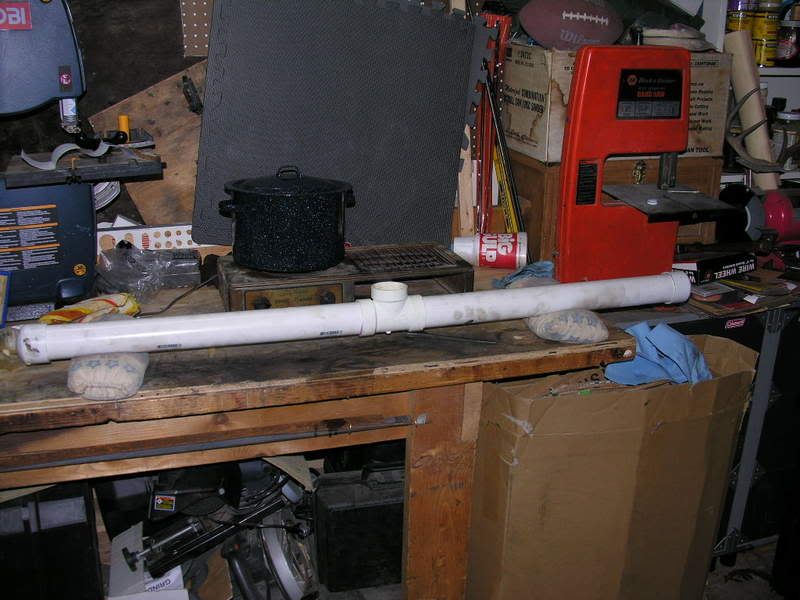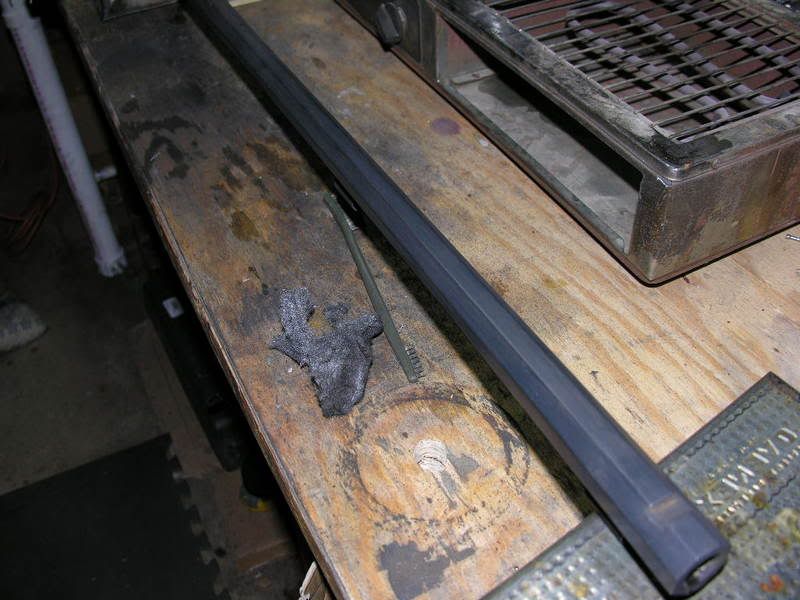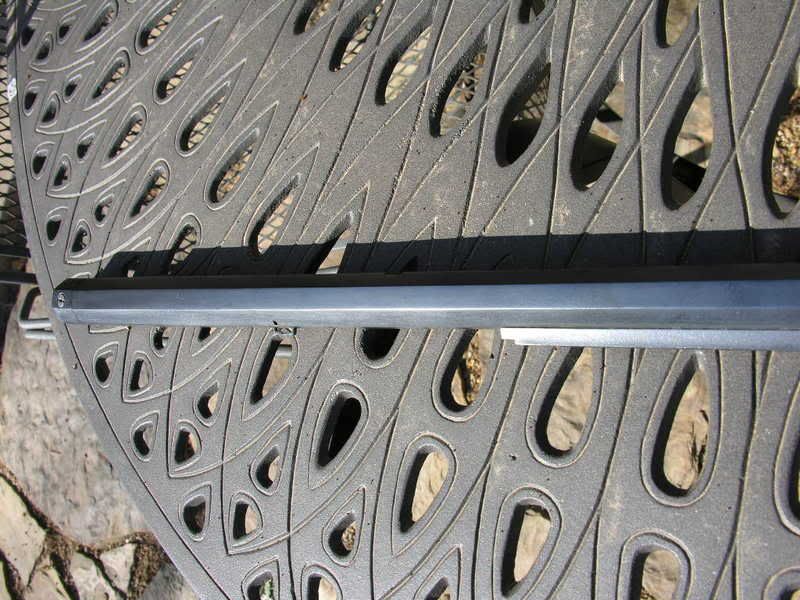I recently rust blued my English halfstock using Laurel Mountain Forge and was not happy with the results. I followed the same procedures I've always used to brown with and the blue finish was much rougher than I wanted; I think I let it rust too long and was not agressive enough in carding.
So I decided to reblue using Mark Lee Express Blue. After removing the old LMF blue (not easy BTW, it's very durable) I repolished and degreased the barrel and parts. To use the Mark Lee blue, you heat the part to 200 degrees and apply the solution. The part will flash rust whereupon it is boiled for 5 minutes. The part is then carded with steel wool and the whole process repeated until the desired depth of color is obtained. However, you do not need a boiling tank to do a barrel.
I made a scalding tank from two 24" segment of 2" PVC pipe joined together with a T joint with dome caps on each end (see first pic). The T joint and one end cap are glued on, the other cap is removable. Following the instruction that come with the bluing, the solution is applied to the heated barrel. Be sure to wear rubber gloves. When dry,the barrel is slid into the pipe and the dome cap is tapped onto the open end. It fits tight enough that it will not leak. I propped the tube on sandbags so it could easily be leveled. Boiling water is poured through the T joint until the pipe is full. You can monitor the color change through the T joint opening. After 5 minutes I empty the pipe by slowly rotating it so that the water flows out the T joint into a bucket. Once all the water is out, I remove the dome cap and slide the barrel out. It will be very hot and dry quickly, leaving a very fine, velvety black coating. The coating is removed by carding with degreased fine steel wool. It came off very easily and only required light rubbing. If you work quickly enough the barrel will still be very warm. The next coat of bluing is applied and will flash rust the barrel quickly. If not, heat the barrel slightly with a heat gun or torch. Once dry, repeat the entire process. The instructions say 6-10 coats will be needed. I used 7 but found that the barrel did not get appreciably darker after the 5th coat. Once the desired depth of finish is obtained, the bluing is neutralized by soaking the barrel in a solutin of baking soda and water for 30 minutes.
It took me about 5 hours to blue all the metal parts on my rifle, including the barrel. Once you get the process going, it is easy to get into a rhythm of carding, rusting and bluing. The finish was a very nice blue-black and very smooth and even with no streaks or blotches. I was very pleased with it. I'm sure I could improve my results with the LMF bluing but I found the Mark Lee blue to be very easy to do. You just need to set aside a large enough time block to do it.
PVC scalding tube:

barrel after 3rd round of bluing, before carding:

finished barrel, prior to oiling:

So I decided to reblue using Mark Lee Express Blue. After removing the old LMF blue (not easy BTW, it's very durable) I repolished and degreased the barrel and parts. To use the Mark Lee blue, you heat the part to 200 degrees and apply the solution. The part will flash rust whereupon it is boiled for 5 minutes. The part is then carded with steel wool and the whole process repeated until the desired depth of color is obtained. However, you do not need a boiling tank to do a barrel.
I made a scalding tank from two 24" segment of 2" PVC pipe joined together with a T joint with dome caps on each end (see first pic). The T joint and one end cap are glued on, the other cap is removable. Following the instruction that come with the bluing, the solution is applied to the heated barrel. Be sure to wear rubber gloves. When dry,the barrel is slid into the pipe and the dome cap is tapped onto the open end. It fits tight enough that it will not leak. I propped the tube on sandbags so it could easily be leveled. Boiling water is poured through the T joint until the pipe is full. You can monitor the color change through the T joint opening. After 5 minutes I empty the pipe by slowly rotating it so that the water flows out the T joint into a bucket. Once all the water is out, I remove the dome cap and slide the barrel out. It will be very hot and dry quickly, leaving a very fine, velvety black coating. The coating is removed by carding with degreased fine steel wool. It came off very easily and only required light rubbing. If you work quickly enough the barrel will still be very warm. The next coat of bluing is applied and will flash rust the barrel quickly. If not, heat the barrel slightly with a heat gun or torch. Once dry, repeat the entire process. The instructions say 6-10 coats will be needed. I used 7 but found that the barrel did not get appreciably darker after the 5th coat. Once the desired depth of finish is obtained, the bluing is neutralized by soaking the barrel in a solutin of baking soda and water for 30 minutes.
It took me about 5 hours to blue all the metal parts on my rifle, including the barrel. Once you get the process going, it is easy to get into a rhythm of carding, rusting and bluing. The finish was a very nice blue-black and very smooth and even with no streaks or blotches. I was very pleased with it. I'm sure I could improve my results with the LMF bluing but I found the Mark Lee blue to be very easy to do. You just need to set aside a large enough time block to do it.
PVC scalding tube:

barrel after 3rd round of bluing, before carding:

finished barrel, prior to oiling:







